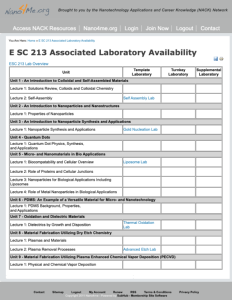E SC 213: Materials in Nanotechnology Laboratories

These laboratories, Nanotechnology Applications and Career Knowledge Support Center (NACK Center), are part of the Engineering Science 213 Course titled Materials in Nanotechnology. Titles of the Laboratories include: Self-Assembly Lab, PVD: Gold Nucleation Analysis (Gold Nucleation Lab), Flourescent Tagging of Liposomes (Liposome Lab), Furnace Oxidation Lab (Thermal Oxidation Lab), and Reactive Ion Etch Lab (Advanced Etch Lab). The Materials in Nanotechnology course is available to view separately.
In the PVD: Gold Nucleation Analysis Lab, students "watch a series of videos pertaining to the processing, annealing, and subsequent analysis of PVD gold thin films," which simulate a laboratory activity. After watching the videos and analyzing the data, students will answer review questions that are provided online. This activity incudes the following objective:
- Investigate surface mobility properties and analyze surface nucleation as a result of heat treatment.
In the Self Assembly Lab, students "watch a series of videos pertaining to the bottom up nanofabrication process of self-assembly," which simulate a laboratory activity. After watching the videos and analyzing the data, students will answer review questions that are provided online. This activity incudes the following objective:
- Explore the formation of self-assembled monolayers on various surfaces and to assess the success of monolayer formation on these surfaces by measuring water droplet contact angles.
In the Flourescent Tagging of Liposomes Lab, students use gel chromotography to "contrast two sets of liposomes with tags in the aqueous core or tags in tags in the lipid bilayer of the liposome." The activity includes the following objectives:
- This lab examines the liposome as a carrier of fluorescent tags used in cancer identification.
- The liposomes will be created from raw materials, tagged, extruded to a proper size, filtered, and characterized.
In the Furnace Oxidation Lab, students "watch a series of videos pertaining to each step of the thermal oxidation process," which simulate a laboratory activity. After watching the videos and analyzing the data, students will answer review questions that are provided online. This activity incudes the following objective:
- Demonstrate and overview the procedures necessary to operate the Lindberg tube furnace.
In the Advanced Etch Lab, students "watch a series of videos pertaining to the dry etch process and the characterization steps used to obtain the data presented in the lab handout," which simulate a laboratory activity. After watching the videos and analyzing the data, students will answer review questions that are provided online. This activity incudes the following objective:
- Demonstrate the dry etch process and determine the resultant etch rates of multiple materials by analyzing data obtained throughout the experiment.

Comments